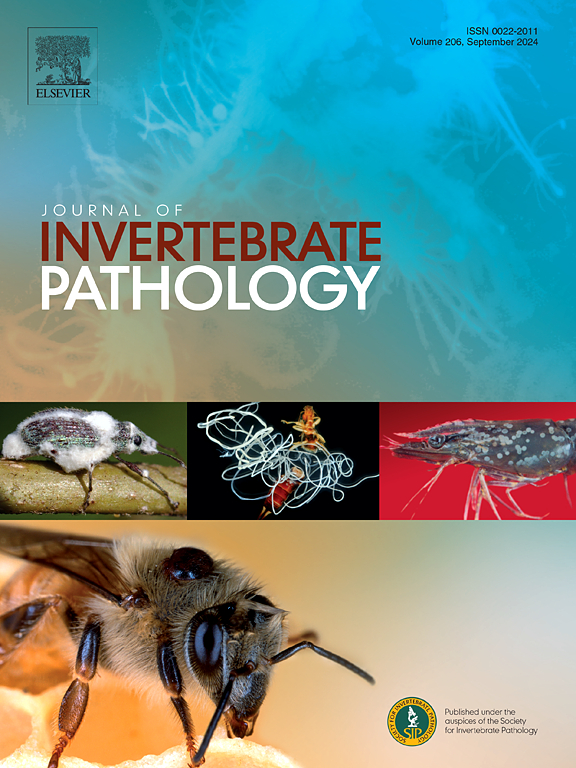Knockdown of Dorsal switch protein 1 Effect on Growth, Development, and survivability of Tenebrio molitor (Coleoptera: Tenebrionidae)
IF 3.6
3区 生物学
Q1 ZOOLOGY
引用次数: 0
Abstract
Dorsal switch protein 1 (DSP1) of insects and high mobility group box 1 (HMGB1) protein of vertebrates are homologous. Both HMGB1 and DSP1 act as damage-associated molecular pattern (DAMP) molecules. Previous studies reported that DSP1 plays a DAMP role in mealworm, Tenebrio molitor, by activating immune genes like antimicrobial peptides (AMPs), phospholipase A2 (PLA2), phenoloxidase (PO) and regulating nodulation. However, RNAi of Tm-DSP1 suppresses these genes and their immune responses. While the immune role of DSP1 is established, its function in growth, development and survivability of T. molitor larvae is unknown. This study was designed to assess the role of DSP1 in the above-mentioned aspects. Tm-DSP1 gene was expressed in all the developmental stages and tissues of T. molitor larvae. The highest expression was observed in L6 larval stage and fat body tissue. Tm-DSP1 detection by western blotting supports its expression in T. molitor samples. Following bacterial challenge, DSP1 expression was upregulated in immune-related tissues, including hemocyte, fat body, and midgut. Detection of increased DSP1 in bacteria-challenged plasma ensures the release of DSP1 in plasma from the cell nucleus of immune-challenged larvae. Additionally, RNAi knockdown of Tm-DSP1 led to reduced larval growth (body length) and development (body weight) of T. molitor larvae resulting in increased mortality of the larvae. These findings suggest that DSP1 regulates the growth, development, and survival of T. molitor. However, whether DSP1 directly plays a role in these physiological processes or whether it interrupts any other genes to achieve these effects is still unknown. Further study is required to clarify this issue.

背侧开关蛋白1的敲低对黄粉步甲生长发育及存活的影响(鞘翅目:黄粉步甲科)
昆虫的背侧开关蛋白1 (DSP1)与脊椎动物的高迁移群盒蛋白1 (HMGB1)具有同源性。HMGB1和DSP1都是损伤相关分子模式(DAMP)分子。已有研究报道,DSP1通过激活抗菌肽(AMPs)、磷脂酶A2 (PLA2)、酚氧化酶(PO)等免疫基因并调节结瘤,在粉虫中发挥DAMP作用。然而,Tm-DSP1的RNAi抑制了这些基因及其免疫反应。虽然确定了DSP1的免疫作用,但其在T. molitor幼虫的生长发育和存活能力中的功能尚不清楚。本研究旨在评估DSP1在上述方面的作用。Tm-DSP1基因在褐飞蛾幼虫的各个发育阶段和各组织中均有表达。在L6幼虫期和脂肪体组织中表达量最高。western blotting检测Tm-DSP1支持其在T. molitor样品中的表达。细菌攻击后,DSP1在免疫相关组织(包括血细胞、脂肪体和中肠)中的表达上调。在细菌攻击的血浆中检测到增加的DSP1,确保了免疫攻击幼虫的细胞核释放血浆中的DSP1。此外,RNAi敲低Tm-DSP1基因,会导致小夜蛾幼虫的生长(体长)和发育(体重)减少,导致小夜蛾幼虫死亡率增加。这些结果表明,DSP1调控了T. molitor的生长、发育和存活。然而,DSP1是否直接在这些生理过程中起作用,或者它是否中断任何其他基因来实现这些作用仍然未知。需要进一步的研究来澄清这个问题。
本文章由计算机程序翻译,如有差异,请以英文原文为准。
求助全文
约1分钟内获得全文
求助全文
来源期刊
CiteScore
6.10
自引率
5.90%
发文量
94
审稿时长
1 months
期刊介绍:
The Journal of Invertebrate Pathology presents original research articles and notes on the induction and pathogenesis of diseases of invertebrates, including the suppression of diseases in beneficial species, and the use of diseases in controlling undesirable species. In addition, the journal publishes the results of physiological, morphological, genetic, immunological and ecological studies as related to the etiologic agents of diseases of invertebrates.
The Journal of Invertebrate Pathology is the adopted journal of the Society for Invertebrate Pathology, and is available to SIP members at a special reduced price.

 求助内容:
求助内容: 应助结果提醒方式:
应助结果提醒方式:


